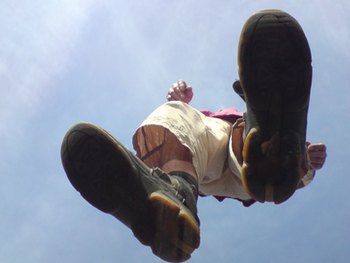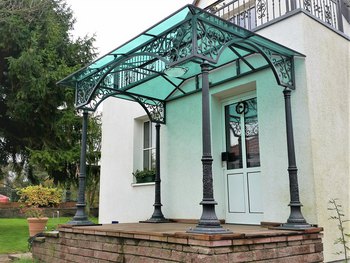Non-insulating roof glazing for terrace roofs, front door canopies, cold winter gardens, balcony roofs, cellar outlets are generally made of laminated safety glass made of float glass (LSG made of float).
It is the cheapest and most common roof glazing, which can be described as largely hail-proof. The thickness of the glass depends, among other things, on the local snow load and the width of the pane. Glass lengths of up to 4600 mm and longer in one piece are possible – however, when such long panes are used, it should be borne in mind that these panes also have a considerable weight and must be brought upside down and laid there.

The panes offered by us meet the legal requirements in Germany. For example, laminated safety glass for overhead glazing must consist of two float glass panes, each at least 4 mm thick, and a double PVB film (0.76 mm thick), i.e. VSG 8 mm 0.76 film. This film is firmly laminated between the panes so that the unit forms a bond. In this case the total thickness of the pane is 8.76 mm – for laminated safety glass 10 mm with 0.76 mm film corresponding to 10.76 mm pane thickness.
Disc weight
VSG 8 mm approx. 20 kg/m²
VSG 10 mm approx. 25 kg/m²
VSG 12 mm approx. 30 kg/m²
or in short: a 1 mm glass weighs 2.5 kg per m².
In laminated safety glass made of float (LSG), neither drillings nor cut-outs nor penetrations (e.g. for stainless steel chimneys or gutter downpipes) should be made in order not to endanger the stability; it can only be laid linearly and not with glass point holders or clamp fastenings.
Due to the laminated foil LSG is an excellent protection against burglary. If the pane is destroyed, the glass adheres to the tough elastic film and must first be removed with difficulty. This means work and deterrence of possible intruders.
The PVB foil also provides almost complete protection against the skin-damaging UV-A radiation of the sun.
The clear PVB film is invisible and cannot be seen through.
In addition to the clear film, the following films are also frequently used for design reasons or reasons of privacy: light matt (matt white) – grey – ocean blue – bronze
Laminated safety glass made of partially tempered glass (LVG) is the safest type of roof glass that is prescribed for public buildings in many federal states. LSG made of LVG is used wherever special protection appears necessary or cut-outs and drillings have to be made.

LVG is less flexible than toughened safety glass (toughened safety glass) and has a different fracture pattern. As a rule, it is only used in combination. The technically max. producible glass thickness is LVG 12 mm as laminated safety glass, i.e. LSG 24 mm consisting of 2 x LVG 12 mm.
Point storage and cut-outs are possible.
Wired glass is flat glass with a wire inlay and is almost only used in industry, in trade fair construction or for optical design.
Insulating glass units
In the overhead area can be carried out with the following types of glass:
The outer pane is usually made of float (flat glass) or TSG (toughened safety glass), while LSG or LSG made of TVG is used for the inner pane.
The combination of hardened toughened safety glass as the outer pane and laminated safety glass on the inside of the room is the classic roofing for conservatories. The hardened toughened safety glass is difficult to destroy on the surface and can withstand almost any hail.
By different procedures (wafer-thin coating with noble metal, colouring of the TSG, gas filling of the space between the panes with argon or krypton gas) a good protection against solar radiation and overheating as well as a high thermal insulation effect can be achieved with this combination.
Glass thicknesses: The required glass thickness depends, among other things, on the dimensions of the panes and the local snow load zone.
Functional glasses
Sun protection: Sun protection glass such as Antelio or Stopsol is used to reduce excessive heating of the interior. The protective effect is essentially based on the reflection of the radiation by coloured and/or highly tempered panes.
Sound insulation: The improvement of sound insulation is achieved by increasing the glass thickness, joining different glass thicknesses and/or using laminated glass with embedded plastic film. The sound insulation of a pane is measured in decibels. This value expresses by how much the sound level decreases when passing from the outside of a window to the inside.
Burglar protection: Burglar-resistant glass can be used to protect against burglary. These glasses consist of at least two panes connected by security film or polycarbonate plastic plates. Depending on the intended protective effect, the superstructures are of different thicknesses.